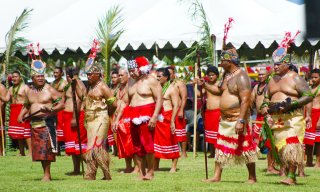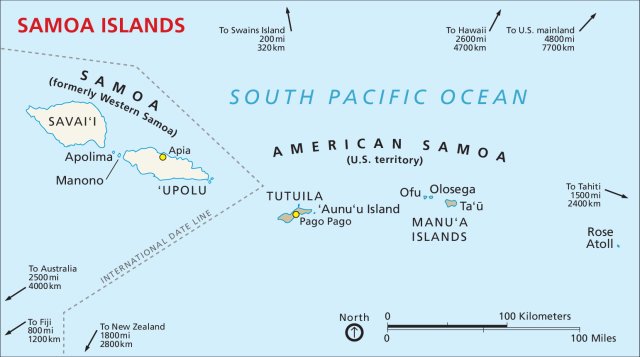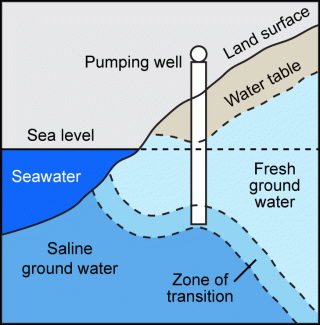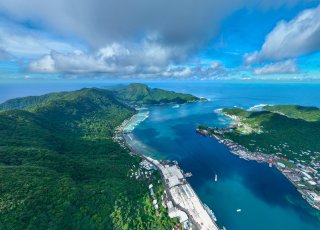Climate Change Connections: American Samoa (Freshwater Resources)
Climate change is impacting all regions and sectors of the United States. The State and Regional Climate Change Connections resource highlights climate change connections to culturally, ecologically, or economically important features of each state and territory. The content on this page provides an illustrative example. As climate change will affect each state and territory in diverse ways, this resource only describes a small portion of these risks. For more comprehensive information about regional climate impacts, please visit the Fifth National Climate Assessment and Climate Change Impacts by Sector.
On this page:
Introduction: Fresh Water in American Samoa—A Precious but Vulnerable Resource

American Samoa is part of the Samoa Archipelago in the South Pacific. The territory comprises seven islands. Most of the population of almost 50,000 lives on Tutuila, the largest island in American Samoa.1 Humans are believed to have first inhabited the Samoa Archipelago nearly 3,000 years ago.2 Today, many American Samoans practice fa'asamoa, or the Samoan way.3 Islanders have preserved many aspects of their traditional Samoan social structure, and more than 90 percent of the population speaks Samoan.4
Fresh water is one of American Samoa’s most precious natural resources. Rainfall supplies the primary source of fresh water, seeping through the soil and recharging each island’s groundwater reserves.5 In areas where groundwater reaches the surface, springs form and feed island streams. Almost all of the water supplied by American Samoa’s public water utility is sourced from groundwater.5 In areas not serviced by the public utility, villages rely primarily on surface water for their water supply.6

Both groundwater and surface water sources in American Samoa are vulnerable to saltwater intrusion and contamination from agricultural runoff. On each island, fresh groundwater floats on top of a denser layer of salt water.5 If too much fresh groundwater is pumped at a well or if a well is drilled too deep, salt water can seep into groundwater reserves, contaminating the fresh water.6 Runoff and contamination from wastewater, fertilizers, pesticides, and manure from farmed animals can also contaminate both groundwater and surface water sources.5
Climate Impacts: Sea Level Rise Is Expected to Increase Saltwater Contamination of Groundwater Resources

Sea level rise and resulting saltwater contamination are growing threats. American Samoa is already experiencing higher rates of sea level rise than the global average, due both to climate change and the island’s geology. Globally, warming temperatures are causing sea level to rise. Warming temperatures affect sea level through the addition of water from melting land ice (glaciers and ice sheets) and the expansion of water itself due to warming ocean temperatures.7Since a 2009 earthquake, the islands of American Samoa have been gradually sinking in a process known as subsidence, which further exacerbates the impacts of relative sea level rise.8 Relative sea level change refers to how the height of the ocean rises or falls relative to the land at a particular location. While absolute sea levels are rising globally, the change in relative sea level varies based on local factors.
Sea level rise due to climate change is expected to further increase saltwater intrusion into American Samoa’s groundwater. Since salt water cannot be used for irrigation or drinking without desalination, saltier groundwater can increase treatment costs for drinking water facilities or render wells unusable.9 Some wells in American Samoa already have more than four times the EPA-recommended chloride concentrations for drinking water.6
Warmer Temperatures and Variable Rainfall are Likely to Affect the Quantity and Quality of Fresh Water
American Samoa is getting warmer, which could increase demand for fresh water. As temperatures rise, so do evaporation rates, putting stress on surface water reservoirs and increasing the need for supplementary crop irrigation. Since the mid-20th century, the average number of days above 90°F per year in American Samoa has increased from about nine days to about 22 days by the 2010s.10 Temperatures are expected to continue to rise with climate change, which places increased strain on water resources.11
Climate models differ in predictions about how annual rainfall may change in American Samoa due to climate change.12 Some models suggest that the frequency and intensity of extreme rainfall events may increase in the future.10 While increased heavy rainfall can help recharge groundwater and surface water resources, it could also significantly increase runoff,13 which can cause flooding and lead to water quality issues.
During extreme rainfall events, pathogens and pollution from agricultural areas and wastewater are flushed into the water system at high rates, which can contaminate water resources.10 This inflow can increase risk of waterborne diseases from drinking water. In response to dangerous levels of pollutants, American Samoa’s public water utility has started proactively shutting down some wells during storms.6 High levels of bacteria can trigger a “boil water notice,” where the public is advised to boil water before use.14 Streams and shorelines used for recreation can also become unsafe for human use. With predictions of up to 50 percent more runoff on Tutuila Island with future climate change,13 water quality issues will likely be an increasing cause for concern.

Taking Action: Protecting Water Resources in a Changing Climate
Addressing climate change requires reducing greenhouse gas emissions while preparing for and protecting against current and future climate impacts. Communities, public officials, and individuals in every part of the United States can continue to explore and implement climate adaptation and mitigation measures. In American Samoa, natural resource managers and communities are taking steps to protect freshwater resources, including:
- Monitoring. Improving and expanding current water and climate monitoring provides valuable information about the status of water resources.5 Monitoring enables managers to track how much water is available and when the risk for contamination has increased. Researchers from University of Hawaii Water Resources Research Center and the American Samoa Power Authority have already successfully established more climate, water quality, and streamflow monitoring equipment to help alleviate this issue.5 The University of Hawaii also provides technical support and training to local organizations so communities in American Samoa have agency to monitor their own resources.
- Reducing pollution sources. Reducing sources of polluted runoff can help decrease contamination of water resources. For example, a project to improve water quality in Afuelo Stream on Tutuila Island included moving pig farms further away from the stream and installing structures to contain and direct waste and manure runoff from the farm. These efforts helped reduce E. coli levels in the stream by more than 90 percent.15
- Rainfall conservation. Strategies such as expanding the use of household rainwater collection systems that have filtration devices could also help reduce pressure on public water systems and improve water security for households.14 These types of projects, in combination with a range of other water quality and conservation projects, can help make American Samoa’s water resources more resilient to climate change impacts.
To learn more about climate change impacts in American Samoa and the other U.S.-Affiliated Pacific Islands, see Chapter 30 of the Fifth National Climate Assessment.
Related Resources
- Sustaining Water Supply in American Samoa (U.S. Climate Resilience Toolkit)
- Climate Change in American Sāmoa: Indicators and Considerations for Key Sectors (Pacific Islands Regional Climate Assessment)
- National Park of American Samoa (National Park Service)
References
1 U.S. Census Bureau. (2021). Population of American Samoa 2010 and 2020. Retrieved September 18, 2023, from https://www2.census.gov/programs-surveys/decennial/2020/data/island-areas/american-samoa/population-and-housing-unit-counts/american-samoa-phc-table01.pdf
2 NOAA. (n.d.). History. National Marine Sanctuary of American Samoa. Retrieved September 14, 2023, from https://americansamoa.noaa.gov/learn/history.html
3 National Park Service. (n.d.). People. National Park of American Samoa. Retrieved September 14, 2023, from https://www.nps.gov/npsa/learn/historyculture/people.htm
4 Levine, A., & Allen, S. (2009). American Samoa as a Fishing Community (NOAA Technical Memorandum NMFS-PIFSC-19). https://repository.library.noaa.gov/view/noaa/3654/noaa_3654_DS1.pdf
5 U.S. Climate Resilience Toolkit. (2024). Collaborating for Success: Sustaining Water Supply on a Pacific Island. Retrieved September 14, 2023, from https://toolkit.climate.gov/case-studies/collaborating-success-sustaining-water-supply-pacific-island
6 Wallsgrove, R., & Grecni, Z. (2016). Water Resources in American Samoa: Law and Policy Opportunities for Climate Change Adaptation. Pacific Regional Integrated Sciences and Assessments Program. https://www.eastwestcenter.org/publications/water-resources-in-american-samoa-law-and-policy-opportunities-climate-change
7 Leung, L. R., Terando, A., Joseph, R., Tselioudis, G., Bruhwiler, L. M., Cook, B., Deser, C., Hall, A., Hamlington, B. D., Hoell, A., Hoffman, F. M., Klein, S., Naik, V., Pendergrass, A. G., Tebaldi, C., Ullrich, P. A., & Wehner, M. F. (2023). Ch. 3. Earth systems processes. In A. R. Crimmins, C. W. Avery, D. R. Easterling, K. E. Kunkel, B. C. Stewart, & T. K. Maycock (Eds.), Fifth National Climate Assessment. U.S. Global Change Research Program. https://doi.org/10.7930/NCA5.2023.CH3
8 Han, S.-C., Sauber, J., Pollitz, F., & Ray, R. (2019). Sea Level Rise in the Samoan Islands Escalated by Viscoelastic Relaxation After the 2009 Samoa-Tonga Earthquake. Journal of Geophysical Research: Solid Earth, 124(4), 4142–4156. https://doi.org/10.1029/2018JB017110
9 US EPA. (2016, May 2). Climate Adaptation and Saltwater Intrusion. Climate Change Adaptation Resource Center (ARC-X). Retrieved November 9, 2023, from https://www.epa.gov/arc-x/climate-adaptation-and-saltwater-intrusion
10 Keener, V., Grecni, Z., Tagarino, K. A., Shuler, C., & Miles, W. (2021). Climate Change in American Sāmoa: Indicators and Considerations for Key Sectors. Zenodo. https://doi.org/10.5281/ZENODO.4663397
11 Frazier, A. G., Johnson, M.-V. V., Fortini, L. B., Giardina, C. P., Grecni, Z. N., Kane, H. H., Keener, V. W., King, R., MacKenzie, R. A., Nobrega-Olivera, M., Oleson, K. L. L., Shuler, C. K., Singeo, A. K., Storlazzi, C. D., Wallsgrove, R. J., & Woodworth-Jefcoats, P. A. (2023). Ch. 30. Hawaiʻi and US-Affiliated Pacific Islands. In Fifth National Climate Assessment. U.S. Global Change Research Program. https://doi.org/10.7930/NCA5.2023.CH30
12 Dhage, L., & Widlansky, M. J. (2022). Assessment of 21st Century Changing Sea Surface Temperature, Rainfall, and Sea Surface Height Patterns in the Tropical Pacific Islands Using CMIP6 Greenhouse Warming Projections. Earth’s Future, 10(4), e2021EF002524. https://doi.org/10.1029/2021EF002524
13 Shuler, C., Brewington, L., & El-Kadi, A. I. (2021). A participatory approach to assessing groundwater recharge under future climate and land-cover scenarios, Tutuila, American Samoa. Journal of Hydrology: Regional Studies, 34, 100785. https://doi.org/10.1016/j.ejrh.2021.100785
14 Kirs, M., Moravcik, P., Gyawali, P., Hamilton, K., Kisand, V., Gurr, I., Shuler, C., & Ahmed, W. (2017). Rainwater harvesting in American Samoa: current practices and indicative health risks. Environmental Science and Pollution Research International, 24. https://doi.org/10.1007/s11356-017-8858-z
15 EPA. (2006). Section 319 Nonpoint Source Program Success Story: American Samoa (EPA 841-F-06-003B). https://www.epa.gov/sites/default/files/2015-11/documents/as_afuelo.pdf

